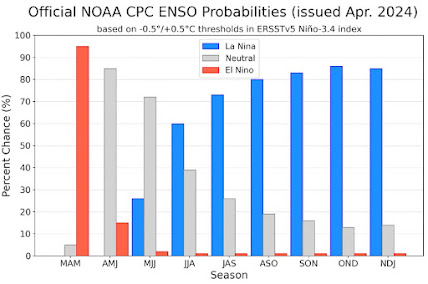India is poised to have a good monsoon this year. It can be seen for the NOAA graph of Fig. 1 below. El Nino conditions are changing to La Nina from May June July.
Fig. 1: ENSO Probabilities by NOAA
This year,
the Southwest Monsoon is anticipated to arrive in extreme parts of South-SE Bay
around the first week of May, gradually progressing northward. Seasonal
Forecast as given by IRI in Fig. 2 below.
Fig. 2: Seasonal Forecast by IRI
Regional Outlook:
The monsoon season may extend into early October this year.
- Western and Northwestern India: Above-normal to excess rainfall is possible over most parts of Western and Northwestern India, including Gujarat, Rajasthan, Punjab, Maharashtra, Telangana, Madhya Pradesh, and Chhattisgarh. This increased Rains is likely to raise concerns for potential flooding, especially during the peak and late monsoon seasons. Rains are likely to be favorable to all Kharif Crops.
Fig. 3: Rainfall forecast by IMD
- Southern and Southeastern India: While the overall monsoon pattern suggests normal to above-normal rainfall, certain areas of Tamil Nadu and Rayalaseema may experience increased weather activity due to La Niña conditions.
- Eastern and East-Central India: There is a slight probability of below-normal rainfall in parts of Eastern and East-Central India, attributed to the influence of La Niña and a Negative IOD. However, this is expected to be localized as most regions are likely to experience near-normal rainfall conditions.
For Kharif
crops, including rice, maize, cotton, and pulses, the forecast brings hope.
Most parts of West/NW India, Gujarat, Rajasthan, Punjab, Himachal Pradesh,
Maharashtra, Telangana, Madhya Pradesh, Chhattisgarh, Goa, Karnataka, and
Kerala are likely to experience above-normal to excess rainfall. This abundance
of rainfall will possibly give a positive impact for the growth and yield of
Kharif crops in these regions. However, there is a slight probability of
below-normal rainfall over some parts of Eastern and East-Central India.
Looking
ahead to Rabi season, the favourable monsoon conditions are expected to have a
positive effect. The extended monsoon, possibly into early October, could
ensure ample soil moisture for Rabi crops such as wheat, barley, mustard, and
pulses. This prolonged moisture availability will support germination, growth,
and development thus leading to potentially higher yields during the Rabi
season.
Currently,
the forecast suggests overall favourable conditions but there might be a
possibility of increased rains in Tamil Nadu and Rayalaseema due to La Nina
influence. Additionally, the probability of excess rains in certain regions,
particularly West/NW India, raises concerns for potential floods during the
peak and late monsoon season. Farmers in flood-prone areas are advised to take
necessary precautions to protect their crops and livelihoods.
Conclusion:
The weather forecast presents a positive outlook for both Kharif and Rabi crop cultivation. With above-normal to excess rainfall predicted in many agricultural regions, farmers have the opportunity to optimize their planting strategies and maximize yields. However, it's essential to remain vigilant, especially in flood-prone areas, and adapt farming practices accordingly to ensure a successful harvest. Also, it is advised to farmers to regularly check the weather forecast of their village area via Fasal Salah App and keep themselves updated.
Fasal Salah App👉 https://goo.gl/5Yu1u9



Great blog! The insights shared are really useful and well-presented—looking forward to more content like this!
ReplyDeleteNDIS Consulting Services
NDIS Certification
NDIS Verification